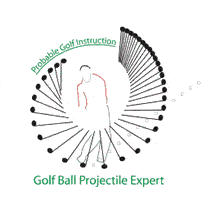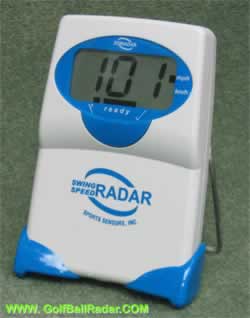
|
|
Downhill & Uphill PuttsHow much harder do you need to hit an uphill putt? How much softer do you need to hit a downhill putt? This page will answer those two questions. Similar to the spreadsheet I've created to model golf ball trajectories, I've also created one the models how a ball rolls over the surface of a green. Using this, I take into account the speed of the green (stimpmeter reading) and the slope of the green (in degrees that can be measured using a BreakMaster Green Reader). Here are the results for a uphill putt on a 1.0 degree slope with a stimpmeter reading of 12 ft (quite fast).
The 'Distance' column displays the physical distance to the hole. the 'Speed' column displays the ball speed required to travel that distance uphill. The 'Normal' column displays how far the ball would roll given the speed on a level green (0 degree slope). So, a 20 footer uphill would need to be struck with enough speed so that it would travel 26.2 feet on a level green. Thus, one would want to aim about 6 feet past the hole on this uphill putt. Here are the results for a downhill putt on a 1.0 degree slope with a stimpmeter reading of 12 ft (quite fast).
Note the 'Slope' column indicates negative 1.0 degree, the negative meaning downhill. A 20 foot putt would need to be struck downhill with enough speed so that it would travel 15.5 feet on a level green. Thus, one would want to aim 4.5 feet short of the hole on this downhill putt. I've replicated this analysis for different sloped greens and for different speed greens (slow, medium, fast, stimpmeter) and written the results up as one of my useful golf tips. The tips will give you an easy routine to follow to determine how much longer (uphill putts) or shorter (downhill putts) your putts will play, thus taking the guess work out of your putting stroke. Knowing how far a putt will play will enable you to putt with more confidence. And, as you probably know, amateurs 3 putt way more often than pros, not because they under read the amount of break, but because they either come up way short or way long. You can order my putting procedure here for $19.99 by clicking the PayPal Logo. You can purchase the putting procedure, reading and playing the wind & reading and playing elevation changes for $39.99 by emailing me at probablegolf@yahoo.ca To analyze and uphill and downhill putt, it is easiest to use conservation of energy. Do you remember your junior science or your high school physics? In any system of objects, total energy is conserved. Once a putt is struck, it has kinetic energy. That energy is transformed into thermal energy due to friction as the ball rolls along the grass. On very fast greens, friction is small thus a putt rolls a long ways before all of its kinetic energy is transformed into thermal energy. For a flat putt, the conservation of energy equation would be: kinetic energy before = thermal energy after 0.5mv*v = Fd where m is the mass of the ball, v is the initial speed, F is the frictional force and d is the distance the ball rolls (the * symbol represents multiplication). The frictional force, F, is equivalent to: F = µmg where µ
is the coefficient of friction that depends on the roughness
of the surfaces and g is the acceleration of gravity (9.8
m/s2 or
Combining the two above equations yields: 0.5mv*v = µmgd which simplifies to: 0.5v*v = µgd and thus the distance a putt travels depends on the inital speed of the ball, µ and g. d = 0.5v*v/ µg A stimpmeter gives a golf ball and inital speed of about 6 ft/s. If a ball is rolling up a hill, then there is another energy transformation of kinetic energy into gravitational potential energy. Thus, on an uphill putt, the conservation of energy equation would be: kinetic energy = thermal energy + grav energy 0.5mv*v = Fd + mgh 0.5mv*v = µmgd + mgh 0.5v*v = µgd + gh where h is the vertical height gained by the ball. Because some of the original kinetic energy of the ball is transformed into gravitational potential energy, it doesn't roll as far. To compensate, the golfer must give the ball more kinetic energy. On a flat putt, the ball would travel a larger distance. On an uphill putt, the extra distance is translated into height instead. Thus, instead of the extra energy translating into distance, it translates into height. The gain in gravitational potential energy is equal to the extra distance the ball would travel on a flat surface. Thus, µmgd = mgh µgd = gh µd = h d = h/µ When putting uphill, the ball must have extra speed comparable to travelling an extra distance on a level surface. That extra distance equals the height gained divided by the coefficient of friction. On a medium speed green (stimpmeter = 9.5), a putt that rises one foot must be hit like trying to knock the ball 17 feet past the hole on a level surface (d = 1 ft/ 0.059). Thus if one has a 20 foot putt up a 1 foot rise hill, the ball must be hit so that it would travel 37 feet on a flat green. A golfer must judge the vertical rise of the putt and know the green's speed. Note: A 20 foot putt with 1 foot rise equates to a slope of 3 degrees, which is very steep. For a 20 foot putt, stimp is 12.5, elevation change is 1 foot, I would basically need to add 23 feet to my putt (if uphill), making the total putt length 43 feet. Note this is relative to a fast green with stimp of 12.5. Now if I have the same 20 foot putt, stimp is 7.5, elevation change is 1 foot, I need to add ONLY 13 feet to my putt (if uphill), making the total putt length only 33 feet. Note that this is relative to a slow green with stimp of 7.5, not to a different speed such as a 12.5 stimp. On fast greens, the relative difference is greater than on slow greens. This is one of the reasons fast greens are more difficult. On a downhill putt, the situation is reversed. One would need to try to hit the ball 17 feet short of the hole for the same scenario as above. One would play a 20 foot putt as a 3 foot putt. That's why on many downhill putts, especially on fast greens, it's difficult to stay short of the hole. ©Probable Golf Instruction, Ken Tannar 2001-2015. All Rights Reserved. Langley, B.C. V2Y 2G4 CanadaPhone: 604-309-7030 FAX: to fax, email an attachment probablegolf@yahoo.ca or golfexpert@probablegolfinstruction.com |
| GOLF ASSISTANTS |
|
Golf Trip Pairing CalculatorPlanning a golf trip with some friends/family? Trying to sort out the foursomes so people don't play too often with others? Order your ready made Spreadsheet. Type in the names, print out the groupings. Minimize repeat pairings.
Wind Caddy will advise you on aim, distance and club so that you can play the wind successfully. It takes the guess work out of club selection. New option to enter custom distances for each club. The algorithm will make a club suggestion accordingly. Use the right club in every condition!
|
|
|
| GOLF NEWS |
Golf Putting Green Reading Glasses |
| GOLF NEWSLETTER |
Statistics
·Putting
·Longest Golf Balls
·Games
·Handicap
·Scoring
·Shot Patterns
·Tournaments
·PGA Tour Stats
Pro Shop
·Ball Marker Engraved
·Books
·CDs & DVDs
·Green Reader
·Impact Labels
·Laser Rangefinder
·Longer Drives
·Products
·Teaching Aids
|
|
| GOLF POLL |
The 19th Hole
·Advertising
·Ask the Golf Expert
·Consultation/Litigation
·FAQs
·Golf Blog
·Golf Draws
·Links
·Science of Golf
·Tell a Friend
·Testimonials
·

Golf Ball Finder Glasses
Find all your errant golf balls and many more!
| GOLF TIPS |
How to play:
|




